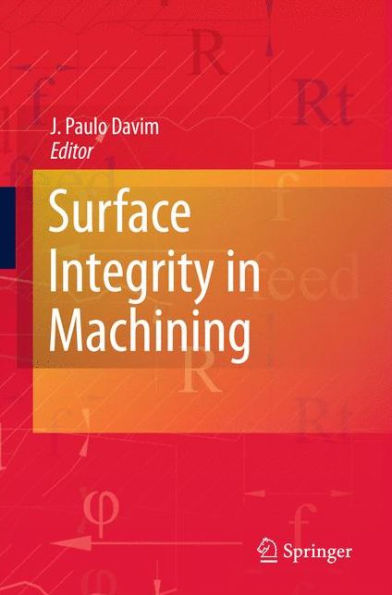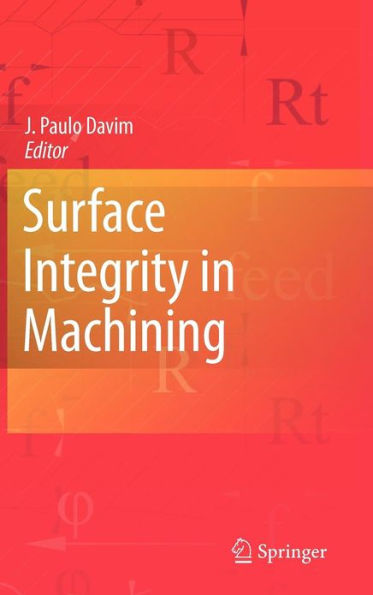Table of Contents
List of Contributors xi
1 Surface Integrity - Definition and Importance in Functional Performance Viktor P. Astakhov 1
1.1 Introduction 1
1.1.1 Historical 2
1.1.2 General Surface Considerations 5
1.1.3 Real Surfaces of Solids 6
1.2 Surface Integrity: Known Notions 7
1.2.1 State-of-the-art 7
1.2.2 Some Typical Defects of the Machined Surface Affecting its SI 9
1.2.3 Obsolete Parameters in SI Data 16
1.3 Surface Integrity: A New Vision 17
1.3.1 Problems with the Existing Notions of SI 17
1.3.2 Definition 20
1.3.3 Surface Integrity vs. Material Degradation 22
1.3.4 Surface Integrity Requirements Depend on the Working Conditions 25
1.4 Concluding Remarks 30
References 32
2 Surface Texture Characterization and Evaluation Related to Machining Georgios P. Petropoulos Constantinos N. Pandazaras J. Paulo Davim 37
2.1 General Concepts of Surface Topography 37
2.1.1 Introductory Remarks 37
2.1.2 Essential Definitions 38
2.2 Surface Texture Parameters 41
2.2.1 Arithmetic Parameters 41
2.2.2 Statistical and Random Process Functions and Parameters 43
2.2.3 Other Morphological Parameters 46
2.2.4 Fractal Geometry Analysis 48
2.2.5 ISO Standards on Surface Finish 48
2.3 Shape Characterization of Surface Roughness Profiles 49
2.3.1 Functional Significance of Parameters 51
2.4 Surface Texture Anisotropy 51
2.5 Association of Roughness Parameters with Machining Conditions 53
2.5.1 Theoretical Formulae 53
2.5.2 Actual Surface Roughness 55
2.5.3 Experimental Trends of Roughness Against Machining Conditions 55
2.5.4 Range of Roughness ' Cutting Processes 62
2.6 Correlation of Surface Roughness and Dimensional Tolerances 63
2.7 Surface Typology 64
2.7.1 Typology Charts 64
References 66
3 Residual Stresses and Microstructural Modifications Janez Grum 67
3.1 Development of Surface Integrity 67
3.2 Residual Stress Sources 69
3.3 Residual Stress and Microstructure After Turning 72
3.3.1 Residual Stresses After Turning of Re-sulfurized Austenitic Steels 72
3.3.2 Residual Stresses and Microstructure in the Surface After Turning Heat-treatable Steel 75
3.3.3 Influence of Tool Material Microstructures 80
3.3.4 Influence of Flank Wear on Residual Stress Formation 81
3.3.5 Residual Stresses After Dry Turning 83
3.3.6 Residual Stresses and Microstructures After Hard Turning 84
3.4 Modeling of Turning and Hard Turning of Workpiece Materials 98
3.5 Residual Stresses After Milling 102
3.6 Residual Stresses and Microstructures at the Surface After Grinding 104
3.7 Modeling of Thermally Induced Damage in Grinding 115
References 124
4 Characterization Methods for Surface Integrity Jianmei Zhang Z.J. Pei 127
4.1 Surface Roughness Measurement Technologies 127
4.1.1 Electronic-type Measurement 128
4.1.2 Optical-type Measurement 129
4.1.3 Scanning Probe Microscopy Technologies 131
4.2 Microstructure Characterization Technologies 133
4.2.1 X-ray Diffraction 133
4.2.2 Electron Diffraction 134
4.2.3 Cross-sectional Microscopy 135
4.3 Elementary Analysis Technologies 136
4.3.1 X-ray Fluorescence 136
4.3.2 Others 137
4.4 Chemical Composition Analysis Technology 138
4.5 Microcrystalline Structure and Dislocation Density Characterization Technology 139
References 140
5 Surface Integrity of Machined Surfaces Wit Grzesik Bogdan Kruszynski Adam Ruszaj 143
5.1 Introduction 144
5.1.1 Machining Surface Technology 144
5.1.2 Factors Influencing Surface Integrity 146
5.2 Surface Texture in Typical Machining Operations 150
5.2.1 Turning and Boring Operations 150
5.2.2 Drilling and Reaming Operations 152
5.2.3 Milling Operations 153
5.2.4 Hard Machining Operations 155
5.2.5 Broaching and Burnishing Operations 156
5.2.6 Grinding Operations 157
5.2.7 Non-traditional Machining Operations 158
5.3 Strain Hardening and Microstructural Effects in Machining 160
5.3.1 Physical Background 160
5.3.2 Built-up-edge Phenomenon 161
5.3.3 Microstructural Effects (White Layer Formation) 162
5.3.4 Distribution of Micro/Nanohardness 165
5.4 Residual Stresses in Machining 168
5.4.1 Physical Background 168
5.4.2 Models of the Generation of Residual Stresses 169
5.4.3 Distribution of Residual Stresses into Subsurface Layer 170
5.4.4 Special Finishing Treatments Improving Stress Patterns 174
5.5 Inspection of Surface Integrity 175
5.5.1 Possible Defects of Machined Surfaces 175
5.5.2 Part Distortion due to Improper Process Performance 178
References 179
6 Surface Integrity of Micro- and Nanomachined Surfaces M.J. Jackson 181
6.1 Micromachining 181
6.2 Machining Effects at the Microscale 182
6.2.1 Shear-angle Prediction 183
6.2.2 Pulsed Waterdrop Micromachining 187
6.3 Nanomachining 194
6.3.1 Cutting Force and Energy 194
6.3.2 Cutting Temperatures 196
6.3.3 Chip Formation 197
6.4 Surface Integrity 199
6.4.1 X-ray Diffraction 199
6.4.2 Scanning Tunneling and Atomic Force Microscopy 201
6.4.3 Surface Spectroscopy 206
6.5 Conclusions 208
References 208
Index 213






